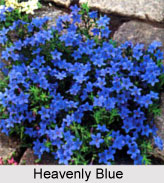 The climbing plant that can always be easily recognized by its dense, green coloured curtain of foliage and large, lavender-blue coloured flowers is the "Heavenly Blue". They can be grown in patio containers, an old sink, between paving stones, in dry-stone walls or in a rockery - so are perfect for small, modern gardens, patios or balconies. This plant grows in acidic soil and therefore fits well in the heather garden. The rock garden is also a good place, but calcareous soil is not well-tolerated by this plant.
The climbing plant that can always be easily recognized by its dense, green coloured curtain of foliage and large, lavender-blue coloured flowers is the "Heavenly Blue". They can be grown in patio containers, an old sink, between paving stones, in dry-stone walls or in a rockery - so are perfect for small, modern gardens, patios or balconies. This plant grows in acidic soil and therefore fits well in the heather garden. The rock garden is also a good place, but calcareous soil is not well-tolerated by this plant.
Different Names of Heavenly Blue Plant
It is famous in the name of "Thunbergia Grandiflora" to the botanists of the world and is a member of the family named "Acanthaceae". The name "Thunbergia" commemorates the Swedish botanist Karl Thunberg. In Hindi, it is named as "Mulata" and in English; it has got the names of "Blue Trumpet Vine", "Clock Vine" and "Sky Flower". This plant is a native of Bengal, Assam and Chittagong and is now found in the gardens of all over India.
Characteristic Features of Heavenly Blue Plant
There are two varieties of this plant. One variety has soft leaves and small sized flowers the other has rough, hairy leaves and a more dynamic growth. The latter one will be discussed here. The flowering branches of the "Heavenly Blue" are long and pendent. The flowers appear in opposite direction and sometimes also in pairs. The pairs are about couple of inches in length. The flowers may be seen open along each branch. Each of the flowers consists of a longish stem and a thick, green coloured calyx and a long, broad corolla. The calyx is greatly marked with purple-red. It is slender towards the base, pointed at the apex and nearly divides into two segments when the corolla emerges. The corolla is about 5 to 7.5 cm in length.
The tube of the plant is whitish outside and more yellow inside. It narrows upwards in the middle before enlarging into a bell-shape. This shape opens into five circular, spreading lobes. The base of each of the lobes, particularly the lower projecting one, is caked with white. The other parts of the lobes totally are of a lovely, pastel mauve colour. Before the lobes wither, the flowers fall down and leave the empty calices for a while. The flowering period of the "Heavenly Blue" is principally from the month of March until the end of the Rainy season. However, one may see the odd flowers throughout the year.
The leaves vary considerably in size, shape and colour. The new ones are of a bright, clear green colour and when they pass through the pink-tinged baby age, they are narrow oval shaped and become thin to a long point. The matured leaves are of a deep, dark green colour and much broader than the young ones. They sometimes appear almost like hearts in shape. Their edge is either complete or it develops two or three indefinite, pointed lobes. The leaves of the "Heavenly Blue" appear in opposite direction on 7.5 cm across stems and they are quite widely spaced along the stout branches. The leaf branches are long and slender and sometimes terminate in bracts. As a garden climber, it is better to keep the plant under control by means of well-judged pruning and it can also be trained over a fence or other strong support.



















